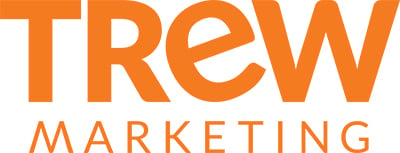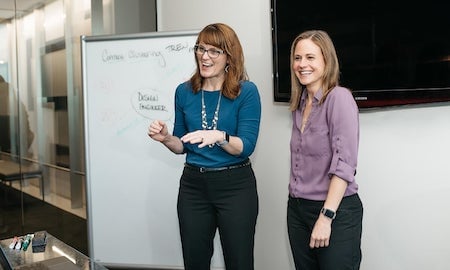Define Your Target Audience
Whether your company is a startup with one product or service, or a multimillion dollar enterprise with a diverse client base, it’s smart to break down the large pool of potential customers into audience segments, called buyer personas.
Creating personas is a straightforward process and allows you to customize your messaging and marketing to each group’s concerns and needs.
Buyer Personas are fictional representations of your ideal customers based on demographic data, online behavior, and your educated speculation about personal histories, motivations, and concerns.
For example, you may define one of your personas as VP of Engineering Val, a business executive who cares most about cost and long-term support.
A second persona could be Engineer Evan, an engineering manager or senior staff engineer who is an expert in your technology area and wants to do a deep dive into the technical capabilities of your product or how you deliver a service.
Evan greatly influences Vince, but Val makes the final decisions. Val and Evan have very different concerns. They want varying types of information about your company and product, and they go to different places to find their information.
By walking through the exercise of understanding your customer segments, such as Val and Evan, you can put faces, personalities, job descriptions, and key elements of the buying decision to each and better customize your website and marketing efforts, from messaging to content selection.
With this approach, you ultimately produce more effective marketing that has a greater impact on your prospects and, in turn, increases your marketing efficiency.
Identify and Prioritize Personas
The first step in creating your buyer personas is to brainstorm who they could be. Personas consist of both end-user customers and influencers, and you likely need to include both types.
To develop a comprehensive list, think of your typical buying process.
- With whom do you first engage?
- Who influences that person?
- Who makes the final decision?
- Are your personas different across industries, product lines, service types, or company size?
Once you have your full list, identify the ones who have similar needs or roles and consider merging them.
From here, prioritize your list of personas by considering their impact on the final purchase decision, their relationship to your company, and the size of the audience persona group.
For example, if a key influencer group has only a few members, you may decide it’s best for sales to own those relationships and not have marketing prioritize them as a larger group.
By the time you’re done, you ultimately want to have three to five primary personas because having more becomes too complex to segment, especially when you’re just starting.
Once you’ve finished brainstorming, create your actual personas. To do this, identify the following types of information for each persona. Start by creating three personas and then build from this number to further refine them and generate new ones as needed.
- Who are they? Include demographics such as gender, age, location, and education/degree.
- What is their job? Include data such as title, company size, industry, career path, and general job responsibilities.
- What is a day in their life like? Describe what an average day is like for them, who they work with, how they prefer to communicate, and what decisions they make.
- What are their primary pain points? Describe the primary challenges they are trying to overcome that relate to your products and services.
- What do they value most and what are their goals? Explain what they value most in making a purchase decision (price, support, etc.) and what they are trying to accomplish in their application.
- Where do they go for information? Identify the primary sources they use to gather information in their research and purchase decision processes.
- What type of information do they prefer? Consider the style of content they are seeking: content that inspires vs. concise guidance vs. a very thorough process including all of the research, specs, and small print.
- What’s important to them when selecting a vendor? List what is most important, such as being a technology leader, having proven experience, being a domain expert, etc.
- What are their most common objections? List the reasons you hear most often for why your solutions will not meet their needs.
Example Persona Exercise
The best way to explain personas is to use examples.
Let’s talk about Oil/Gas Engineer Evan.
A first step in developing your personas is to select a photo. You don’t have to start with a photo, but each persona is not complete without one. You may choose the headshot of an actual customer who represents the prospects you want to target, or you can Google the job title to get ideas. It is important you get the photo right, and you will find the debate that ensues in the search for the perfect photo is enlightening.
People often have very distinct images of customer personas. They only wear jeans. They wear designer glasses. They are older. Younger. They look nerdy. Cool. Maybe there is one customer in particular who accurately represents the persona segment. You may want to choose a photo showing the persona at work to give context to the application environment. Keep debating until you find the picture of the person everyone agrees on, and take note of the visual cues throughout the process.
Who is he?
- Male, 20 years of experience in his field
- Master’s or PhD-level degree
- Early adopter of new technology, deeply knowledgeable in related technologies and systems
- At the No. 2 or 3 market-leading Fortune 1000 company
What is his job?
- Oil/gas exploration
- Stays abreast of new technologies, serves as internal technology expert/consultant
What is a day in his life like?
- Works on manufacturing/engineering processes
- Regularly evaluates technologies to assess their potential for meeting his needs
What are his primary pain points?
- Top concern is system reliability
- Secondary concern is finding the best, most reliable new technology
- Cost is a concern only in a few corner application areas
What does he value most and what are his goals?
- Reliability
- Specs
- Ease of integrating new technology into his current system
Where does he go for information?
- Trade shows
- Trade journals
- Respected speakers at technical conferences
- Google
What type of information does he prefer?
- Lengthy data sheets
- Testing benchmarks
- Third-party reports from national labs, academic institutions
- Technical content such as white papers and webcasts by credentialed subject-matter experts inside the company
What is important to him in evaluating vendors/technology?
- Detailed and extensive field and lab testing, third-party testing, reliably proven specs
- Face-to-face meetings, eye contact, high morale
What are his most common objections/concerns?
- Can you pass his business and technology litmus tests?
- Can you do it? Proven? Credible?
What would he be quoted saying?
- “I research new technologies that are proven, reliable, and have the potential to give our systems a competitive edge. Company leaders and my engineering peers rely on my technical opinion, so I am analytical and meticulous in my due diligence. I enjoy working with technology and the engineers who create it, especially when I find an innovative new partner who has promising technology and is trustworthy and technically competent. I keep up by reading technical journals and seeing my cohorts in the industry at technical conferences and symposiums.”
Looking at Oil/Gas Engineer Evan, you can see he’s a well-respected, senior engineer in his energy firm with superior academic and field credentials. He is the go-to guy inside his Fortune 1000 company for opinions on adopting new technologies.
When Evan is researching his products, he goes first to the specifications to determine what is required to integrate a new technology in an existing system.
In the energy sector, existing systems can live in very remote, rugged areas such as on the ocean floor or in desert terrain, and they are very expensive to maintain, so Evan is thorough in his research. He reads all the technical information he can and seeks out quality and test/trial data to see proof of real-world performance.
He must be convinced that the product is proven and reliable before he ever meets with a technical counterpart at the supplier. He has no room for error in his applications, and his reputation is on the line with each decision he makes.
Evan is well known in his tight-knit community of energy technologists, and he gets most of his information from technical conferences, leading academicians, and peers he trusts.
At the end of the description, a fictional quote summarizes the feelings of the persona. Writing this quote serves to add a voice to the persona and helps crystallize what they really care about.
Where is your buyer in the technology adoption lifecycle?
One last element of persona development is to add to your definition is where the persona is on the technology adoption lifecycle. This model for high-tech marketing was made famous by Geoffrey Moore in his book, Crossing the Chasm.
As you can imagine, customer personas can vary widely with differences in educational levels, pain points, care-abouts, preferred information sources, and risk level. By defining these and other elements and finding the right persona photo, you are ready to prioritize your audiences, define your positioning, develop your messaging, plan your content development, and decide on the optimal targeted marketing approach to reach each group.
Another benefit of clearly defining your buyer personas is aligning your organization, from the CEO and sales engineers to R&D and marketing. Many organizations feel a lack of clarity in identifying their customer audiences, and employees often do not fully understand how their actions directly impact potential customers. Even engineering teams are at times charged with creating a new product, but no one is exactly sure who the product is targeted to. Unfortunately, this misalignment can translate into wasted time and resources. For marketing, this reality sets in when you or your team members are reworking content multiple times, debating the topic of your next white paper, or trying to reconcile conflicting opinions that slow down initial, clearly defined objectives.
Using informed data, outside research when needed, and your collective experience to create your personas, and then ensuring leaders in your organization agree and understand them, can result in significant efficiency gains and employee confidence. When these fictional characters start to become part of your regular language and references to Engineer Ed or VP Val lead to heads nodding in agreement and understanding, you will experience the power of personas.






